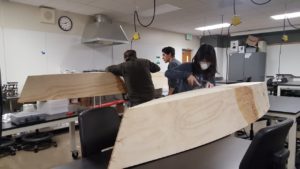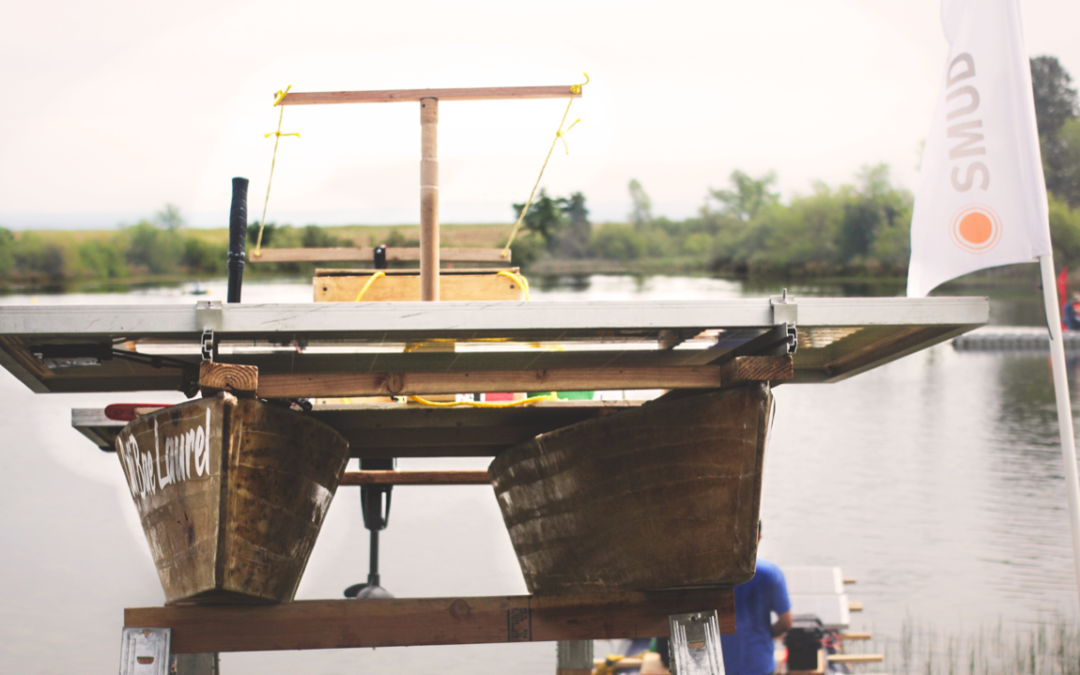Students design and build a solar-powered boat for regional competition
By Christine Byrd, Communications Director
On any given afternoon, the Base 11 Innovation Center at Skyline College is humming with the sound of 3D printers or laser cutters at work, or throbbing with noise as the ShopBot slices large wood pieces.
The students are drawn to the lab for different reasons. Some are taking a class that requires them to design and build their own drone using the rapid prototyping equipment. But others, like electrical engineering student Daniel Messier, are working on their own projects.
“Labs for classes are meant to be hands-on, but it’s a whole different thing when you can watch a YouTube video, go to the lab, and figure it out for yourself,” Messier says. “That’s insanely important.”
Messier and his colleagues in Skyline’s Engineering and Robotics Club have used the Base 11 Innovation Center to produce everything from a 3D printed headphone holders that they sold as a team fundraiser, to building a 9-foot solar-powered boat for a competition.
The MIT-inspired Fab Lab at Skyline College opened in 2016, as a result of an investment by Base 11. With a focus on accelerating diverse students on a pathway to STEM degrees, careers and entrepreneurship, Base 11 installs innovation centers with the goal of giving students opportunities for hands-on learning experiences.
“The Base 11 Innovation Center is all about giving students an opportunity to actually complete projects using the same kind of equipment used in industry — and those experiences will make them highly attractive to future employers,” says Ingrid Ellerbe, SVP of Programs and Partnerships for Base 11. “Most of these students would not be able to gain these real-world skills if not for our labs.”
Last year, Skyline’s Engineering and Robotics Club placed 8th out of 17 schools in the Solar Regatta — an impressive showing considering that competitors included much larger four-year universities. The team relied heavily on the Base 11 Innovation Center to design and build their boat for the competition. This year, the students are focusing on adjusting their designs to make the boat stronger, lighter and more efficient.
“We basically came out of nowhere with this boat,” said Marco Wehrfritz, the lab technician for the Base 11 Innovation Center and adjunct faculty at Skyline College, who also advises the engineering and robotics club. “Now I see our team having in the same possibility as many other teams in improving their boat a little bit more every year.”

Marco Wehrfritz (right) gives students like Mikaela Quintos opportunities to learn computer-aided design in the Base 11 Innovation Center.
Arnaldo Alvarez is one of the students spending hours each week in the lab to improve their boat design. He suggested a catamaran that would be easier to take apart and transport to competition. But he also decided to make the pieces interlock like a puzzle, to be more flexible and sturdy. Alvarez used Solidworks, a computer-aided design software program professionals in industry also use, to redesign the team’s boat. Then he turned to the fab lab’s ShopBot to manufacture the giant pieces.
“Prior to coming to Skyline, I was always jerry rigging stuff,” says Alvarez. “In my family I’m known as the one to fix electronics — and I would try to fix it with my bare hands and screw drivers. Coming here, I get access to materials I cannot get access to at home.”
With their more stable catamaran design complete the team is focusing now on improving the efficiency of the circuits in their solar-powered electrical motor.

“The Base 11 Innovation Center is the right playground for students to come up with good solutions for their projects on their own,” says Wehrfritz. “If you have access to all of our electronic equipment, you will likely find a solution for a powerbank for our solar panels.”
In May, the team will return to Sacramento to race their catamaran and improved solar-powered engine in the California Solar Regatta.
“I feel much more secure in my knowledge and experience because of the projects I’ve done in the fab lab,” says Daniel. “I’ve done a lot more with circuits than I would have done if I didn’t have this place for actual engineering to happen.”

